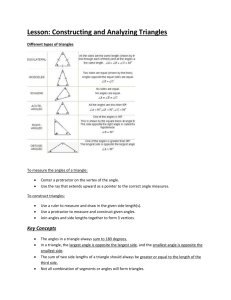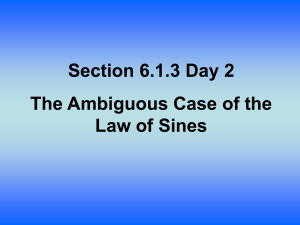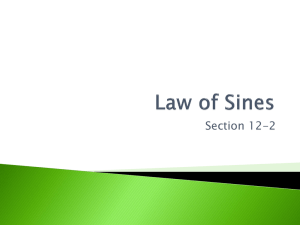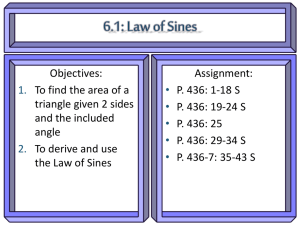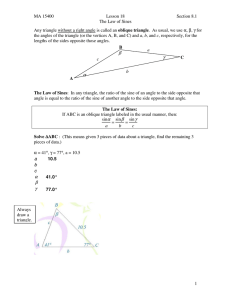Document 10504124
advertisement
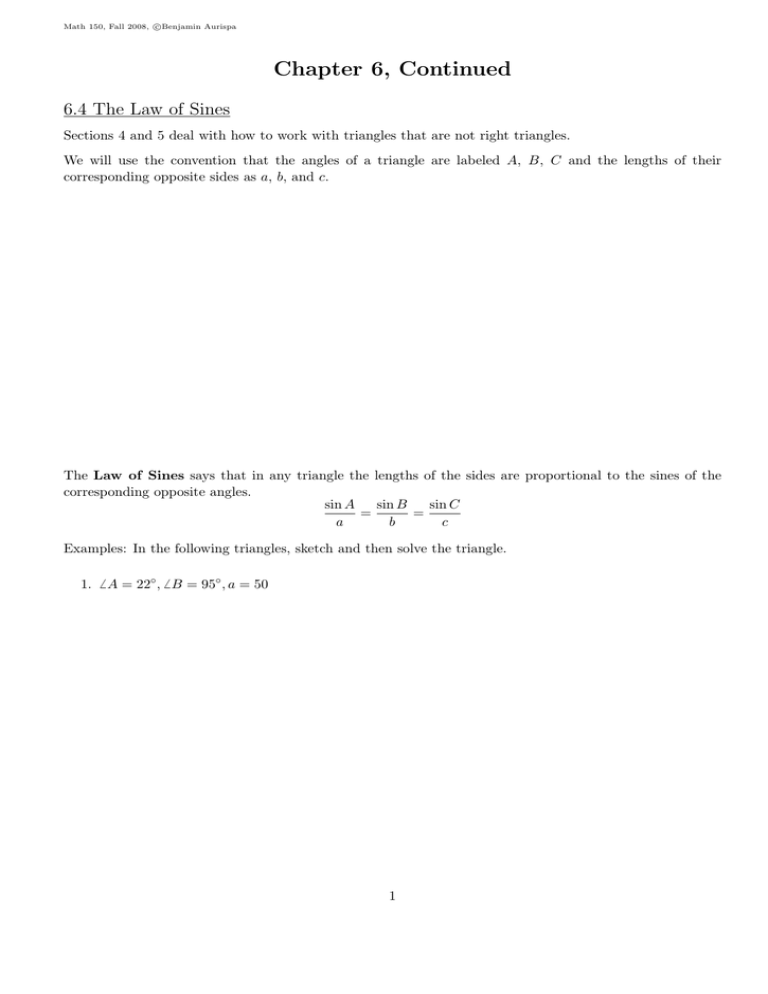
c Math 150, Fall 2008, Benjamin Aurispa Chapter 6, Continued 6.4 The Law of Sines Sections 4 and 5 deal with how to work with triangles that are not right triangles. We will use the convention that the angles of a triangle are labeled A, B, C and the lengths of their corresponding opposite sides as a, b, and c. The Law of Sines says that in any triangle the lengths of the sides are proportional to the sines of the corresponding opposite angles. sin B sin C sin A = = a b c Examples: In the following triangles, sketch and then solve the triangle. 1. 6 A = 22◦ , 6 B = 95◦ , a = 50 1 c Math 150, Fall 2008, Benjamin Aurispa In the above example, we were given two angles, so finding the third angle was easy since we know the angles of a triangle must add up to 180◦ . If you are only given one angle, it gets more complicated. To find θ if you know sin θ, use the inverse sine function, sin−1 , sometimes denoted arcsin. We will deal much more with inverse trig functions later, but for now realize that sin−1 is giving you an angle with the given sine value. The range of f (x) = sin x is [−1, 1], so sin θ must always be between −1 and 1. So, for example, if you get that sin θ = 2, this cannot happen, so there is no solution in this case. If we are given the lengths of 2 sides and an angle opposite one of these sides (SSA), there will be either 1, 2, or no ways to solve the triangle. This is called the ambiguous case. 2. a = 75, b = 100, 6 A = 30◦ 2 c Math 150, Fall 2008, Benjamin Aurispa 3. b = 100, c = 80, 6 B = 135◦ 4. c = 50, a = 100, 6 C = 50◦ 5. What if c = 120 instead? How many triangles are there? 6. A radio antenna is supported by two wires. Each wire is attached to the top of the antenna and anchored to the ground, at two anchor points on opposite sides of the antenna. The shorter wire makes an angle of 42◦ with the ground and the longer wire makes an angle of 31◦ with the ground. The two anchor points are 200 ft apart. How long is the longer wire? 3 c Math 150, Fall 2008, Benjamin Aurispa 6.5 The Law of Cosines The Law of Sines cannot be used when we only know the lengths of all three sides (SSS), or when we only know two sides and the included angle (SAS). In these cases, we must use the Law of Cosines: a2 = b2 + c2 − 2bc cos A b2 = a2 + c2 − 2ac cos B c2 = a2 + b2 − 2ab cos C Examples: Solve the following triangles. 1. b = 60, c = 30, 6 A = 70 2. a = 10, b = 12, c = 16 4 c Math 150, Fall 2008, Benjamin Aurispa A lot of word problems in trig deal with navigation. A direction is given as a bearing: an acute angle measured from due north or due south. For example, N 40◦ W indicates a direction that is 40◦ to the west of north. 3. Two boats leave the same port at the same time. Boat A travels at a speed of 32 mi/h in the direction N 70◦ E and Boat B travels at a speed of 28 mi/h in a direction S 65◦ E. (a) How far apart are the boats after 15 minutes? (b) If both boats stop at this point, what bearing would Boat A have to head in to reach Boat B? 4. Three islands lie in the Pacific Ocean. The distance between Island A and B is 20 mi, the distance between Island B and C is 25 mi, and the distance between Island C and A is 30 mi. Find 6 BAC. 5
